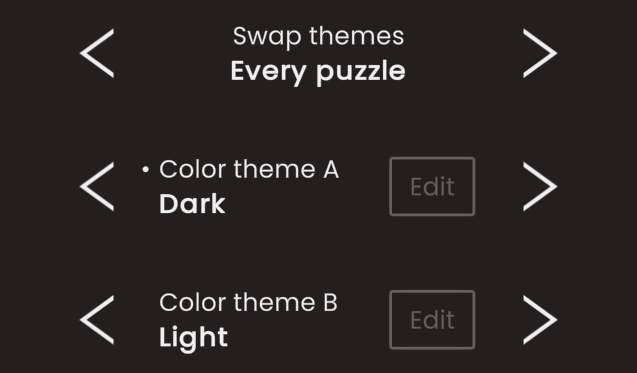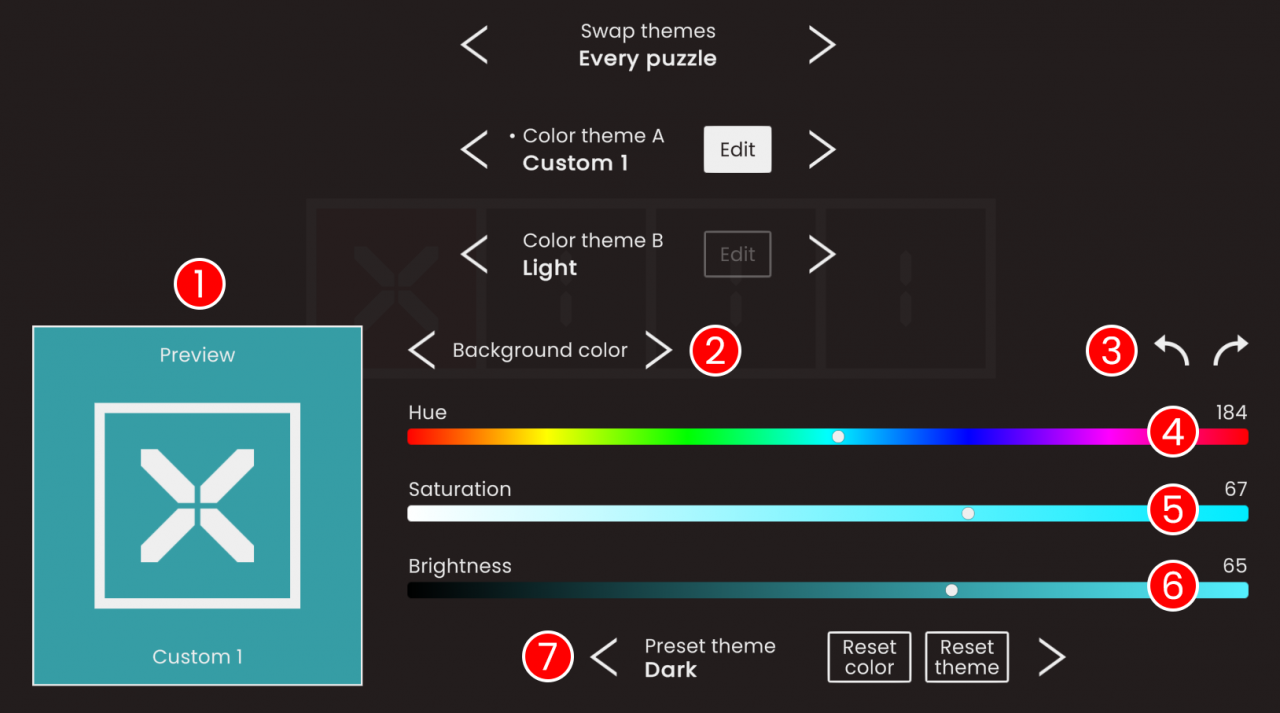A comprehensive guide about customizing the visuals of Cardinal Chains. the game is planned release on 9 September.
About
Cardinal Chains provides many ways to customize its visuals, which can be modified directly from within the game using the options menu. Although these settings were designed to be self-explanatory, you may use this guide to get a comprehensive description of their functionality, including some examples and extra notes.
If you have any comments or requests, feel free to reach me on Twitter @DanielNora999, or send an email to [email protected]. Or just drop a comment below!
Choosing color themes
The options “Swap themes”, “Color theme A” and “Color theme B” allow you to choose what themes are presented during gameplay.
 ⠀
⠀
⠀
Swap themes
- Accepted values: Disabled, Every puzzle (default), Every 2…20 puzzles
⠀ - This setting allows you to define how often color themes will be swapped. Its default value is “Every puzzle”, which means that color themes will be swapped every time the puzzle is changed (i.e., puzzle 1 will use color theme A, puzzle 2 will use color theme B, puzzle 3 will use color theme A, puzzle 4 will use color theme B, and so on). You can change the interval at which color themes will be swapped, up to a maximum of 20 puzzles (i.e., puzzles 1 to 20 will use color theme A, puzzles 21 to 40 will use color theme B, and so on). If you set this to “Disabled”, only color theme A will be used (i.e., color themes will never be swapped).
⠀
⠀
Color theme A and Color theme B
- Accepted values: Dark (default for color theme A), Light (default for color theme B), Wine, Cool, Rosy, Desert, Deuteranopia (green cone color blindness), Protanopia (red cone color blindness), Tritanopia (blue cone color blindness), Custom 1 to 5
⠀ - These settings allow you to choose which color themes will be presented. You can choose from several built-in themes, including options for color blindness. Additionally, you have 5 custom theme slots. These themes can be edited freely by clicking the “Edit” button, which brings up the color theme editor. By default, these themes look exactly like the Dark theme until you make any changes.
⠀ - Setting “Color theme B” to the same theme as “Color theme A” is effectively the same as setting “Swap themes” to “Disabled”.
⠀ - Looking at the image above, you can see a small dot before the words “Color theme A”. This handy indicator shows that, for the current puzzle (and according to the current “Swap theme” setting), this is the theme that is being presented. For example, if “Swap themes” is set to “Every puzzle” and you are playing puzzle 1, the dot will appear before “Color theme A”, while on puzzle 2 it will appear before “Color theme B”.
Editing color themes
When “Color theme A” or “Color theme B” are set to a custom theme, the “Edit” button becomes clickable. When you click the button, the color theme editor will be brought up into view. The next image presents a view of the color theme editor with numbered labels for each of its elements, which are explained below.
 ⠀
⠀
⠀
- Preview: This window allows you to see what the color theme will look like while you are playing.
⠀ - Color selector: This lets you pick the color to be edited. You can edit the background color, interface color and root colors 1 to 9 (root colors are those associated to each different cell marked with an “X” on the puzzle). When you pick a root color for editing, the preview window will automatically display that color inside the “X” cell.
⠀ - Undo and redo: Allows you to undo/redo all changes applied to the color theme that is currently being edited (since the game was started). The undo/redo history is always preserved while the game is open, even after changing themes or closing the options menu, up to a maximum of 100 actions. This history will only be lost when you exit the game. You can click the buttons continuously to undo/redo faster.
⠀ - Hue: Changes the hue of the currently selected color. Can be undone/redone.
⠀ - Saturation: Changes the saturation of the currently selected color, i.e., the intensity or “colorfulness” of the color, with values closer to 0 representing less intensity (pure white). Can be undone/redone.
⠀ - Brightness: Changes the brightness of the currently selected color, i.e., the amount of light emitted by the color, with values closer to 0 representing less light (pure black). Can be undone/redone.
⠀ - Presets: This toolbar allows you to quickly reuse colors from different themes. Use the arrow buttons to pick between different themes (this will not have any effect by itself). Click the “Reset color” button to apply the equivalent color from the selected preset into this theme. Using the example from the image above, clicking the “Reset color” button would make the background color of Custom theme 1 match the background color of the Dark theme. Clicking the “Reset theme” button would do the same for all colors (i.e., it would make Custom theme 1 look exactly like the Dark theme). Both these actions can be undone/redone.
Extra notes
- To maximize the visibility of custom themes, prefer darker interface colors on lighter background colors and vice-versa. Use the built-in color themes as reference.
⠀ - If you make the background and interface colors match (accidentally or not), most of the game’s elements will effectively become invisible. Don’t worry: all the buttons are still there, and the options menu will not be affected (it is always presented in a color with sufficient visibility). To bring your colors back to normal, click around the spot where the options button is located. Once the options menu is open, you can comfortably change your color theme settings again.
⠀ - You can have more than 5 custom themes. In fact, you can have as many themes as you want. To do this, you must manually edit a specific JSON file with a text editor. To prevent accidental data loss, backup your file before editing. The file is “data_themes.json”, and it’s location varies according to each OS:
- On Windows, the file is in “C:\Users\YOUR PROFILE NAME\AppData\LocalLow\Daniel Nora\Cardinal Chains”
- On macOS, the file is in “~/Library/Application Support/Daniel Nora/Cardinal Chains”
- On Linux, the file is in “$HOME/.config/unity3d/Daniel Nora/Cardinal Chains”
Once you open the file, all settings involving color themes can be configured manually. Each custom theme is listed in order inside the “customColorConfigs” list. To add new themes, simply paste them at the end of the list, separated by a comma. Once it’s done, save the file. Now you can edit the new themes directly from within the game. For example, to make a new slot that defaults to the Dark theme, copy the following text and paste it before the file’s penultimate line (notice the comma at the beginning):
,
{
"bg": {
"h": 0,
"s": 16,
"v": 14,
"t": 0
},
"ui": {
"h": 0,
"s": 0,
"v": 94,
"t": 0
},
"roots": [
{
"h": 2,
"s": 78,
"v": 100,
"t": 0
},
{
"h": 120,
"s": 86,
"v": 77,
"t": 0
},
{
"h": 179,
"s": 100,
"v": 71,
"t": 0
},
{
"h": 24,
"s": 100,
"v": 92,
"t": 0
},
{
"h": 294,
"s": 74,
"v": 90,
"t": 0
},
{
"h": 265,
"s": 72,
"v": 94,
"t": 0
},
{
"h": 336,
"s": 86,
"v": 79,
"t": 0
},
{
"h": 210,
"s": 100,
"v": 88,
"t": 0
},
{
"h": 39,
"s": 100,
"v": 66,
"t": 0
},
{
"h": 48,
"s": 21,
"v": 50,
"t": 0
}
]
}
By danijmn
